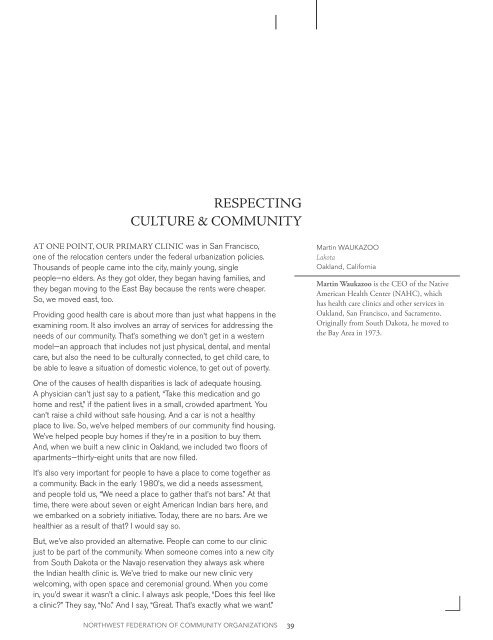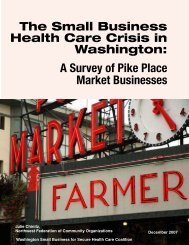www.nwfco.orgANONYMOUSSeattle, WashingtonI want to share the story <strong>of</strong> a little girl I know, who I’ll callLiz, the adopted daughter <strong>of</strong> friends <strong>of</strong> mine. Born addicted to meth andcocaine, Liz had a lot <strong>of</strong> lung problems in her first two years and wasconstantly using inhalers and a nebulizer.Once, her mother told me, they had to rush her to the hospital near thereservation where they live. After asking <strong>for</strong> insurance in<strong>for</strong>mation, theadmitting nurse refused to let Liz be seen—despite her turning blue fromnot being able to breathe—because Liz is in the Indian <strong>Health</strong> Servicesystem. Finally, Liz’s parents took her to the next closest hospital fifteenminutes away.When Liz was five, I was with her when she broke her ankle playing ona trampoline. Her mom said that she knew it was serious, because Liznever cries from pain! We drove to a hospital twenty or thirty minutesaway, because Liz’s mom was afraid the closer one would turn her awayagain. During the drive, we gave Liz herbs to help her relax, and whenwe got the ER she was no longer crying.At the hospital, they didn’t believe her ankle was broken because shewasn’t crying. They didn’t want to do x-rays. We had to insist. Even then,they just scheduled an appointment <strong>for</strong> x-rays the next day!They wouldn’t even give us an exam room to see Liz. They came out tothe waiting room and took Liz’s vitals right there. They even wanted totake her temperature rectally right there! My friend asked if they coulddo it in her ear or mouth instead. The nurse said “Oh, we’ll just skip itthen!” Liz got the x-ray the next day, and her ankle was in fact broken.I’ve had my own problems with the medical system. I was sixteen whenmy grandma died. Despite having diabetes, which she managed well,she was healthy. One day she had a fall and hurt her back. The doctorsaid she was healthy and strong enough <strong>for</strong> surgery. I visited herafterward, and she was her normal silly self. But one <strong>of</strong> the nurses in thehospital put her in a bathtub with stitches in her back, and she caught avirus or infection that attacked her central nervous system. It traveled toher brain, and she eventually went into a coma.There were clear medical instructions: they were not supposed to put herin a bathtub! I can’t help but wonder: if she weren’t an old brown woman,would she have received better care? When she went into the coma, Iused the traditional teachings I had, and made her a bundle <strong>of</strong> medicinethat I prayed with, and I beaded a nice little bag <strong>for</strong> it to go in. I put it onmy grandma in the hospital. When I went back to visit her, the bundle wasgone. For one reason or another, one <strong>of</strong> the hospital staff had taken it.There was a total lack <strong>of</strong> respect <strong>for</strong> our religious/spiritual ways.This wasn’t an isolated incident. Just a few months ago, I had surgery toremove a massive tumor. I told my doctor that I wanted to take the tumorafterward. He laughed at me. I told him I was serious. He didn’t think itcould be saved. I had to go through all sorts <strong>of</strong> channels to fight to havethis tumor saved <strong>for</strong> me. The hospital finally agreed, but I’d have to waittwo whole months be<strong>for</strong>e I could come pick it up. I had <strong>for</strong>ms drawnup and spoke to all the appropriate parties. Yet, after all was said anddone, they didn’t save the tumor. I wasn’t able to handle it the way I wassupposed to according to my cultural and spiritual traditions.38 AN AMERICAN DEBT UNPAID stories <strong>of</strong> native health 2009
RESPECTINGCULTURE & COMMUNITYAt one point, our primary clinic was in San Francisco,one <strong>of</strong> the relocation centers under the federal urbanization policies.Thousands <strong>of</strong> people came into the city, mainly young, singlepeople—no elders. As they got older, they began having families, andthey began moving to the East Bay because the rents were cheaper.So, we moved east, too.Providing good health care is about more than just what happens in theexamining room. It also involves an array <strong>of</strong> services <strong>for</strong> addressing theneeds <strong>of</strong> our community. That’s something we don’t get in a westernmodel—an approach that includes not just physical, dental, and mentalcare, but also the need to be culturally connected, to get child care, tobe able to leave a situation <strong>of</strong> domestic violence, to get out <strong>of</strong> poverty.One <strong>of</strong> the causes <strong>of</strong> health disparities is lack <strong>of</strong> adequate housing.A physician can’t just say to a patient, “Take this medication and gohome and rest,” if the patient lives in a small, crowded apartment. Youcan’t raise a child without safe housing. <strong>An</strong>d a car is not a healthyplace to live. So, we’ve helped members <strong>of</strong> our community find housing.We’ve helped people buy homes if they’re in a position to buy them.<strong>An</strong>d, when we built a new clinic in Oakland, we included two floors <strong>of</strong>apartments—thirty-eight units that are now filled.It’s also very important <strong>for</strong> people to have a place to come together asa community. Back in the early 1980’s, we did a needs assessment,and people told us, “We need a place to gather that’s not bars.” At thattime, there were about seven or eight <strong>American</strong> Indian bars here, andwe embarked on a sobriety initiative. Today, there are no bars. Are wehealthier as a result <strong>of</strong> that? I would say so.But, we’ve also provided an alternative. People can come to our clinicjust to be part <strong>of</strong> the community. When someone comes into a new cityfrom South Dakota or the Navajo reservation they always ask wherethe Indian health clinic is. We’ve tried to make our new clinic verywelcoming, with open space and ceremonial ground. When you comein, you’d swear it wasn’t a clinic. I always ask people, “Does this feel likea clinic?” They say, “No.” <strong>An</strong>d I say, “Great. That’s exactly what we want.”Martin WAUKAZOOLakotaOakland, Cali<strong>for</strong>niaMartin Waukazoo is the CEO <strong>of</strong> the <strong>Native</strong><strong>American</strong> <strong>Health</strong> Center (NAHC), whichhas health care clinics and other services inOakland, San Francisco, and Sacramento.Originally from South Dakota, he moved tothe Bay Area in 1973.NORTHWEST FEDERATION OF COMMUNITY ORGANIZATIONS 39




